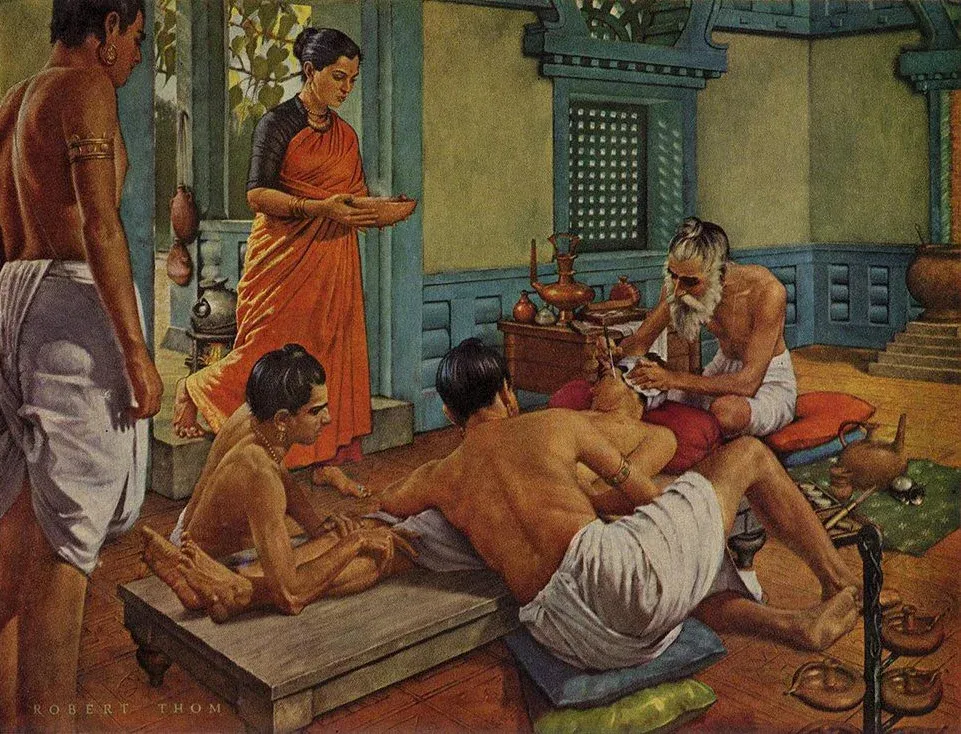Sushruta & his Samhita - Part 1 - Cowasjee

Our story begins in the year 1731.

In the West, America was still 45 years away from gaining independence and in the East, in Pune, the construction of Shaniwar Wada was far from complete. In the bone-chilling winters of England, a young and enterprising lad from a shoemaking family had a bright idea - To print a magazine. He proposed this idea to several people in London but received neither any interest nor the funding. Eventually, he saved the money, bought the machine and printed the magazine himself.
This was the worlds first ever magazine called ‘The Gentleman’s Magazine.’ His self-funded venture became very popular in a short time and several notable and popular authors of the day wrote for this magazine.
The East India Company had ventured into India by then and there was great curiosity about this far-flung land of the East. The magazine enjoyed great success not just in England but in Europe as well, for nearly 200 years until it shut down in 1922.
We are particularly interested in a letter written by one B.L that was printed in the October 1794 publication of The Gentlemen’s Magazine (TGM).
The letter summarises that two British physicians Thomas Caruso and James Findlay had witnessed the rhinoplasty of Cowasjee, a bullock cart driver in the service of East India Company. During the third war between Tipu and the English, Cowasjee worked for the English army ferrying goods and people. He became a prisoner of war and Tipu sultans soldiers chopped off his nose and a hand. Chopping off noses and limbs was a common punishment at the time. Cowasjee made away with his life but lost a hand and his nose in the process.
The curious reason why Cowasjee featured in TGM was the procedure of rhinoplasty that he had undergone to get a new nose!


From Wikimedia CommonsThe procedure that the British doctors witnessed, is as follows. First, a wax mould of his nose was prepared. Then the mould was placed on Cowasjees forehead to outline, then with a regular knife following the outline the skin was cut. The skin was not entirely detached, leaving a small bridging connection between both eyes. Then the wax mould was placed in its proper position and shaped. The skin that was dangling from the forehead was then brought down like a blanket on the wax mould and dressed with medicinal herbs. In a few weeks, the skin is noted to have become planted around this wax mould and the scar on the forehead healed in three months. The letter concludes with “ This operation is very generally successful.”
This article caused a great buzz in Europe because at the time the European doctors had been struggling with a problem. Doctors in Europe would take skin from either the cheek or thigh, but it would become stiff and dry due to lack of blood supply and oxygen rendering the operation unsuccessful.
It was this ingenious procedure that provided the solution, as it kept the skin attached to the forehead, and when blanketed on the wax mould continued to heal due to a regular supply of blood and oxygen. The patient was left with a mark on their forehead, but at least now they had a fully functional nose.
So, who performed such an effective procedure? Instinctively, you’d think, surely it was a skilled surgeon. Well, here is the most surprising detail of the procedure that will make you think again.
The initial letter of Oct 1794 states it was performed by a brick-maker and the picture published in January 1795 calls him a Kumar; ie; Kumbhar…A potter in Marathi.
To recap, a skilled potter in Pune, successfully performed a rhinoplasty in 1794, which shaped the future of rhinoplasty not just in Europe but the world.
The curiosity and the enthusiasm following this article led to the development of surgery and plastic surgery as two fundamentally different branches of medicine. As you will read further in the series, this prompted the West to reconsider instruments used in surgeries as well.
Most importantly, they developed reverence for the Bharatiya system of medicine — Ayurveda and for Sushruta — Father of Surgery. So who was Sushruta? Why is he called the Father of Surgery? Was he a real person or a mythological demi-god?
The picture, from which this engraving is made, was painted in January, 1794, ten months after the operation. Published January, 1st, 1795 by James Wales of Bombay, at Mr,, R. Cribbs, Carver & Gilder 288 Holborn, London.



Follow this series for a fascinating journey to find out more.
Twitter: https://twitter.com/MitraDesai
Youtube: http://bit.ly/TejomayaBharat?sub_confirmation=1
Resources:
1: Edward Cave, engraving by Edward Scriven after a painting by Francis Kyte c.1740
https://en.wikipedia.org/wiki/Edward_Cave#/media/File:Edward_Cave.jpg
2: A Selection of Curious Articles from the Gentleman’s Magazine, Volume 3 By John Walkerhttps://books.google.com.au/books?id=wSEJAAAAQAAJ&pg=PA510&lpg=PA510&dq#v=onepage&q&f=false
3: A singular operation.
https://www.britishmuseum.org/research/collection_online/collection_object_details.aspx?objectId=3596688&partId=1&people=103774&peoA=103774-2-23&sortBy=fromDateDesc&page=1



Comments ()